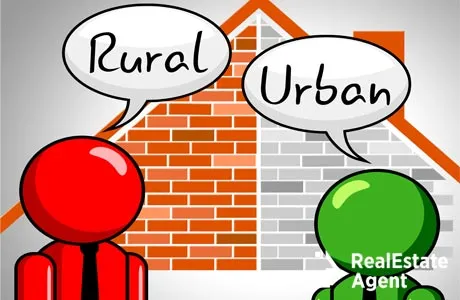 Where is it better to live? Where is living more cost-effective? Where will I have to say hello to everyone I meet? Should I remain in New York City or better move to Jericho 29 miles away? Let our real estate agents help you decide!
Where is it better to live? Where is living more cost-effective? Where will I have to say hello to everyone I meet? Should I remain in New York City or better move to Jericho 29 miles away? Let our real estate agents help you decide!
There are many reasons, pro, and con, for both living in the suburbs or the city. Besides the apparent financial aspects, there is an undeniable style of living characteristic for these two places worth taking a thorough look at.
Suburban areas, or suburbia, are locations that build up around the outskirts of cities. Typically, they tend to be less heavily populated than the cities, though some grow to become cities in their own right.
The discrete charm of the suburbs

The suburbs turned elegantly and stylishly fashionable neighborhoods in the United States in the 1950s. It started as a white-collar privilege, particularly suit-and-tie workers who work in service industries and often avoid physical labor. Like Arlington, Virginia, Frisco, Texas, etc., the most famous suburbs did such an excellent job at improving living conditions that they soon turned into virtual little cities with their own private set of rules. A true sense of community prevails here with a well-established set of rules, where practically everyone knows everybody and is actively involved in social life and neighborhood events. Outsiders are welcome unless they diverge from the beaten track.
Living in the suburbs provides residents with the priceless advantages of more privacy than the city, better public safety, less traffic, an improved schooling system, and almost paradise-like tranquility. Evidently, all these advantages come with a price. On an average basis, the cost of living in the suburbs is regularly lower than in the city, at least considering the home prices. The job market is more impoverished than in metropolitan areas. You probably need a vehicle to get everywhere, because public transportation is rarely as well-organized as in the city. And your daily life enters a routine, which might get monotonous, if not dull.
The adrenaline rush of the metropolis

Paradoxically, maintaining your anonymity and being one of the faceless crowd, the city might just be the perfect place for you. With millions of passers-by and drivers on the jam-packed streets and roads, you can remain unnoticed since everyone is going somewhere ‘fast and furious’ and utterly careless of their surroundings. There is harsh psychology to this aspect of modern living, and it’s not for everyone. If you pursue a career, the chances are that the city is the right choice for you, with a larger range of domains available.
In addition, you are more exposed to cultural and entertainment events, all of these more accessible with a system of enhanced public transportation. Do not forget, though, the price of modern, big city life is stress and a constant lack of time. It can affect your health, and finally, you still have to opt for living in a quiet neighborhood.
The financial aspects of living downtown vs. suburbs
When deciding where to live, it's important to compare rent downtown versus the suburbs. Based on recent studies, Forbes reports that the average rent in a U.S. city is $1,850 per month. In the suburbs, rent drops to $1,270 per month – approximately $580 less per month than city living.
Renting a house can be as complex as purchasing one. It needs careful planning!
Let’s illustrate with a concrete example, in big cities like Dallas, New York, or Philadelphia, living in the city costs at least $600 more per month. A study investigating New York City concluded that families spend over $70,000 more annually within the city than families living in nearby suburbs. Expenses from bank loan agreements to child care resulted in a higher cost of living.
While rent or mortgage is cheaper in the suburbs, fuel expenses will increase due to the long drives from home to the workplace. Owning an apartment in the city slashes down transportation costs but may add to the entertainment and food expenses. For this reason, if you have a family, we recommend a peaceful neighborhood: living in the city is significantly more expensive than living in the suburbs.
When it comes to the housing market, the logical answer is that, yes, it’s probably much cheaper to buy a home in the suburbs. Let’s take Frisco, TX, for example. The evolution of the housing market in Frisco, TX has a median home value higher than the other suburbs.
5 most important factors to consider when choosing between downtown and the suburbs

1. Cost of living
The cost of living is regularly higher in a metropolitan area since the demand for everyday goods and services is higher. Still, depending on where you spend your hard-earned money, the cost breakdown can change between a city and a suburb.
On the one hand, rent or mortgage is cheaper in the suburbs. In addition, fuel expenses will increase due to longer commutes. On the other hand, living in the city considerably reduces transportation costs. Still, the amount spent on entertainment and food can be higher.

2. Time spent on commute
Traveling back and forth to a workplace can be pretty time-consuming. For many commuters, a long journey can make or break accepting a job offer or moving to a different location. If your workplace can be found within the city, living in the city or nearby would also make for a shorter time than driving in from the suburbs.
If you do not own a vehicle, living in the city might be perfect as you can rely on public transportation. Or you can walk or ride a bike. Using public transportation also provides you the chance to catch up on work during your long journey, socialize, or read the news on your mobile device. An extreme case, when your fast access to traffic can be a blessing and a curse is living next to a highway.
3. Demographics
As we mentioned initially, suburbs have mostly been thought up to essentially middle-class. There has been a change in recent years. In 2017, the average city saw a statistical shift as more people moved to the suburbs. This phenomenon grew exponentially once the pandemic emerged in 2020. With this recent desire to move to the suburbs, the financial demographics have changed from being predominantly one of higher income to a number of newcomers with moderate earnings thus making the population more diverse. Suburbs became an appealing destination to move to for the millennial generation too. Thus, they contribute to the change in the average age of the residents.
4. The schooling education and facilities

Having children or planning to start a family in the future is only a matter of time. Therefore, the quality of education matters. Regularly, schools in the outskirts of big cities provide a better education than in the city.
Metropolitan schools can be overcrowded. This may result in worse education for your children. Money comes in schools through property taxes. In conclusion, schools from poverty-stricken inner cities receive less funding than middle-class suburbs.
In the suburbs, more attention is paid to individual children in a private school. On the other hand, young learners might get lost in the imperfect big-city public schools. The debate is still on, whichever form of schooling is better for kids.
5. Type and dimension of living space
Visualizing your future home is quintessential before actually purchasing it to fit your perspectives and lifestyle. Would it provide you with an ideal environment for children and pets?
If you live in the city, home repairs would cost less than a house in the ‘burbs’. Additional costs will emerge with yard work and house refurbishments. Life in the city might give you plenty of opportunities to raise a family; still, if you need space, living in a smaller, quieter neighborhood will be just the thing for you. For a smaller amount of money and investment, you can own a larger private property and call it all yours while you allow your kids and pets to enjoy a larger space!
Since the pandemic broke out, many jobs turned into home office workplaces. Remote work became not only widespread but extremely popular too. A trend, which gave birth to lots of new questions, such as how to set up an office space and many more.
A home in the suburbs provides you with ample space for the years to come instead of conforming to the tight limitations within an overpopulated city.
Future housing trends and conclusions

With the current global political climate and pandemic having in mind, it is challenging to foresee the exact trends the real estate market will follow in the future.
Since living in the city means owning a smaller estate in terms of square footage than in the suburbs, it is highly probable that being a city dweller will cost you as much as being a ‘suburbanite’ , yet you will have less space in your home.
We saw the change in the real estate business caused by political decisions and the COVID-19 pandemic. The government introduced a general lockdown in the metropolitan area. Many have decided to change the urban scenery to favor a larger and more peaceful environment, less densely populated and with more ‘fresh air’. Therefore, the pricing of city properties dropped considerably, while real estate in the suburbs turned into an idyllic destination, naturally, at a higher cost.
Deciding which environment to choose to live in is a tough nut to crack. In this article, we wished to provide you with some basic guidelines to keep in mind before concluding. Obviously, our real estate specialists will be at your disposal to offer further assistance and precious information pertaining to this subject too.
If you have found this article helpful, please give it a big like and share it with your friends on social media!

















Have a question or comment?
We're here to help.